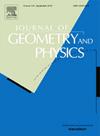The symmetry regularization of 1D generalized Kepler problems
IF 1.2
3区 数学
Q1 MATHEMATICS
引用次数: 0
Abstract
The 1D generalized Kepler problem with magnetic charge is the Hamiltonian system for which the phase space is the total cotangent space of the half line and the Hamiltonian is where is the position and is the momentum. Let be the positive portion of the phase space (i.e., ) and be the negative portion of the phase space. Denote by the co-adjoint orbit of defined by conditions and . It is demonstrated that there is a symplectic embedding : such that the image of is dense and open, and any Kepler motion (i.e. Hamiltonian motion under H) inside , after being embedded via , extends to a complete Hamiltonian motion inside . The positive case is similar, but with replaced by , i.e., there is a symplectic embedding : that satisfies similar conditions. A revelation from the work here is that the term “regularization map” is a misnomer, and the correct name is S-duality, a term that appears in string theory/gauge theory and resembles the Fourier transform.
一维广义开普勒问题的对称正则化
磁荷μ≥0的一维广义开普勒问题是相空间为半线R+:=(0,∞)的总余切空间,哈密顿量为H=12p2+μ22q2−1q的哈密顿系统,其中q∈R+为位置,p∈R为动量。设Σ+为相空间的正部分(即{H>;0}), Σ−为相空间的负部分。用Oa表示sl2(R)≡R1,2的协伴随轨道由条件x02−x12−x22=a2和x0>;0定义。证明了存在一个辛嵌入ι−:Σ−→Oμ,使得ι−的像是密集而开放的,并且在Σ−内的任何开普勒运动(即H下的哈密顿运动)经过ι−嵌入后,扩展到Oμ内的完全哈密顿运动。正的情况是类似的,但用Oμ/2代替Oμ,即存在满足类似条件的辛嵌入ι+: Σ+→Oμ/2。从这里的工作中得到的启示是,术语“正则化映射”是一个用词不当,正确的名称是s -对偶性,这个术语出现在弦理论/规范理论中,类似于傅里叶变换。
本文章由计算机程序翻译,如有差异,请以英文原文为准。
求助全文
约1分钟内获得全文
求助全文
来源期刊

Journal of Geometry and Physics
物理-物理:数学物理
CiteScore
2.90
自引率
6.70%
发文量
205
审稿时长
64 days
期刊介绍:
The Journal of Geometry and Physics is an International Journal in Mathematical Physics. The Journal stimulates the interaction between geometry and physics by publishing primary research, feature and review articles which are of common interest to practitioners in both fields.
The Journal of Geometry and Physics now also accepts Letters, allowing for rapid dissemination of outstanding results in the field of geometry and physics. Letters should not exceed a maximum of five printed journal pages (or contain a maximum of 5000 words) and should contain novel, cutting edge results that are of broad interest to the mathematical physics community. Only Letters which are expected to make a significant addition to the literature in the field will be considered.
The Journal covers the following areas of research:
Methods of:
• Algebraic and Differential Topology
• Algebraic Geometry
• Real and Complex Differential Geometry
• Riemannian Manifolds
• Symplectic Geometry
• Global Analysis, Analysis on Manifolds
• Geometric Theory of Differential Equations
• Geometric Control Theory
• Lie Groups and Lie Algebras
• Supermanifolds and Supergroups
• Discrete Geometry
• Spinors and Twistors
Applications to:
• Strings and Superstrings
• Noncommutative Topology and Geometry
• Quantum Groups
• Geometric Methods in Statistics and Probability
• Geometry Approaches to Thermodynamics
• Classical and Quantum Dynamical Systems
• Classical and Quantum Integrable Systems
• Classical and Quantum Mechanics
• Classical and Quantum Field Theory
• General Relativity
• Quantum Information
• Quantum Gravity
 求助内容:
求助内容: 应助结果提醒方式:
应助结果提醒方式:


